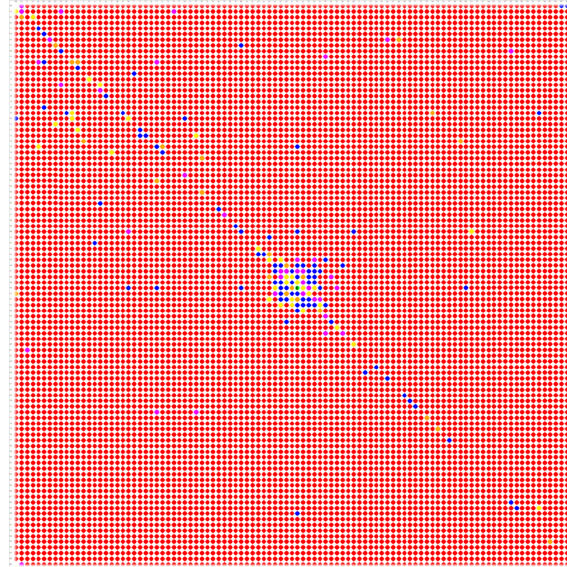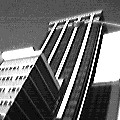
The art
movement in France in the 1950s and 1960s known as the Situationist International
believed strongly in the potential of 'drifting' through a city as a means of
identifying oneself more closely with a sense of personal and political liberty.
Motion through urban space was considered a
revolutionary act one which one undertook personally, making notes as one drifted,
unfolding secret hidden meanings in the traversed city. Immersive video games
also enable this type of drifting, games often build randomness into the rules
of play and the abstraction of the board or screen can
paralell the structures and activities of everyday city life.
dérive:
An experimental mode of behaviour linked to the conditions of urban society:
a
technique for hastily passing through varied environments. Also used, more particularly,
to designate the duration of a prolonged exercise of such an experiment.
unitary urbanism
The theory of the combined use of art and technology leading to the integrated
construction of an environment dynamically linked to behavioural experiments.
Wearable computers make dynamic digital data available to a person at
any time or place. This data can relate directly to the physical environment
itself in an ongoing, conversant and highly complex way. Real world phenomena
which are dynamic and which can be represented digitally can in turn be processed
as they occur, and this data can be seen and heard in-situ by the user.
The user can filter and customise the ways in which data is presented and used.
Just as a computer desktop can be personalised, so can 3D or 2D data projected
in front of the user's field of view by means of head up display.
These developments are likely to impact greatly on the role and function of
contemporary urban planning and architecture. Semiotic structures like signs,
billboards, monitors and markings will become more interactive as they become
more electronic. The imagery on the signs and the size and
shape and animation of those which might appear 3 dimensional and floating in
mid air require a new type of awareness about how digital information can be
made to distill and represent the world around us.
EMU WEBGRID seeks to examine migration over time between places on avirtual
map representing an online city. People claim for themselves a dot within a
grid. They can move to any other position on the grid. Research seeks to identify
what role adjacency and migration play in the growth and
mutability of the city.
Using certain types of technology such as wearable computers with head up display
it is becoming increasingly possible to develop multimedia which interacts with
the physical environment as aspects of it change and as a person moves through
it.
Data shown in this way is by necessity dynamic, changing as the view of the
traversed landscape changes. Information needs now to update with the ever changing
route of the wearer.Little to no research has been done to address the specific
design requirements of this type of dynamic location sensitive audio visual
media.
The aim of designing new types of augmented signage is to enable city dwellers
to take an active part by using digital media in shaping their surroundings.
Urban centres will benefit from technology and media forms which embrace and
encourage the deliberate overlapping of both digital information and physical
space. These hybrid media forms combine the disciplines of architecture, urban
planning,
semiotics, film and animation and choreography - even dance.
It is hoped that new ways of life will stem from the ability to augment the
appearance and sounds of the world we inhabit, especially where these augmentations
can be shared and swapped and integrated into the everyday lives of people.
We can live with intelligent ghosts all around us, each of them talking and
all of us talking with each other and with them. In this way we might become
more in tune, literally with our environment and with each other. We could become
more of a community where the basic principles of civic life can be embraced
and a stronger sense of genuinely shared, open and public space can find expression.
The Situationist theory of the derive is aimed at eliciting from the experience of traversing urban space a sense of one's own liberty.
The Derive: Collective or Individual Libertarianism?
The concept of the derive was promoted as a strategy aimed at enabling people
on an individual level to work with others to identify and chronicle those areas
of cities which provided evidence of phenomena resistant to mainstream commercial
society.
The collective long term revolutionary aims of the S.I. were not considered
outside of the individualistic aspects of some of their strategies. The S.I.
saw no contradiction in acts of individual liberty such as the derive and the
broader, long term goals of revolution.
To the Situationist International, and to Guy Debord who wrote the original
“Theory of the Derive” the fact that drifts were performed by individuals
or by groups had little to do with their overall role to play in the broader
social and political aims of the S.I. Debord even offers advice as to the numbers
of people who at a time should undertake drifts. It is worth considering that
these were not trivial tasks, and could go on for weeks and months at a time:
One can dérive alone, but all indications are that
the most fruitful numerical arrangement consists of
several small groups of two or three people who have reached the same level
of awareness, since
cross-checking these different groups' impressions makes it possible to arrive
at more objective conclusions. It is preferable for the composition of these
groups to change from one dérive to
another. With more than four or five participants, the specifically dérive
character rapidly diminishes, and in any case it is impossible for there to
be more than ten or twelve people without
the dérive fragmenting into several simultaneous dérives. The
practice of such subdivision is in
fact of great interest, but the difficulties it entails have so far prevented
it from being
organized on a sufficient scale.
Guy Debord, Theory of the Derive, 1958
The issue of ‘how many people’ should perform a derive is thus less important than the overall strategy of the activity itself and what it discovers about the city it is examining.


Similarities between Situationist representations of 'drift' through parts of Paris and the EMU WEBGRID. Both share a sense of 'clustering' - where regions indicate areas of interest (e.g. around the centre of the grid). Like drifters through a European city, an EMU WEBGRID user can migrate to any other position on the grid.
The promises of the derive, the experience of traversing urban space to sense
one’s own liberty are deeply inherent in the web grid proposal. The principle
of ‘getting up and moving’ was very much a central idea in the EMU
WEB GRID. Users were to feel they could go and relocate to a different place
if they felt there was more ‘happening’ there, and at the same time
could hang on to their original ‘dot’ position. The idea that you
have to look around, explore, drift on the grid to see what others are doing
transposes the idea of the derive into the process of browsing the actual city.
Just as a person drifts around a real city, users, and visitors alike can ‘browse’
around the grid of EMU, looking for others of like mind, or somewhere to locate
themselves relative to some feature, or lack of features, whatever the case
may be. The idea of being free to wander within the space is key to its structure
and organization. The idea of the grid itself being scalable, able to grow or
diminish with the desires of the population is also a central Situationist idea.
Casio Watch Camera Pictures.
The below black and white pictures were taken using a casio watch camera. The camera takes 120 x 120 black and white pixel images and uses the watch battery to power the camera and to store the pictures (up to 100) in the camera's memory. The camera can be worn on the body at all times, enabling the photography of urban space to occur anywhere and anytime, light levels allowing.
Visual Memory Augmentation
The process of recording one's passage through urban space and uploading these images regularly to a desktop computer enables the memory of the user to be augmented. Interesting visual aspects of the urban landscape need never be totally fleeting, one's chance encounters with events, places and people can be simply recorded for later consideration.

Theory of the Derive
Situationist International Archives